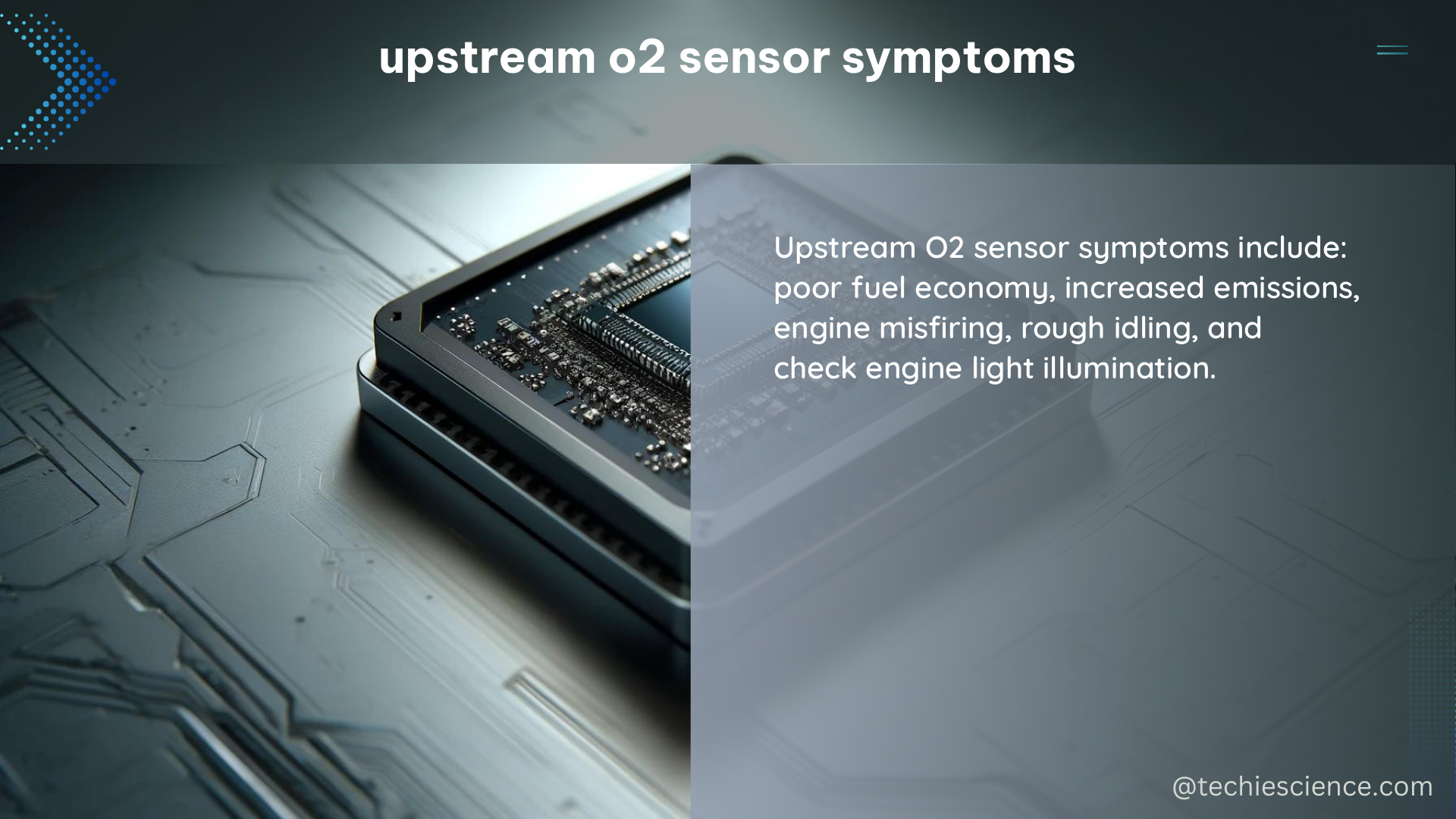The upstream oxygen sensor, also known as the pre-catalyst sensor, is a critical component in the engine management system, responsible for monitoring the air-fuel ratio and providing feedback to the engine control unit (ECU) to maintain optimal combustion efficiency and reduce emissions. When this sensor fails, it can lead to a range of measurable and quantifiable symptoms that can significantly impact the vehicle’s performance, fuel economy, and emissions.
Poor Fuel Economy
A faulty upstream O2 sensor can disrupt the air-fuel mixture, leading to an imbalance that results in increased fuel consumption. According to a study by the U.S. Department of Energy, a malfunctioning O2 sensor can reduce fuel efficiency by up to 40%. This can be attributed to the sensor’s inability to accurately monitor the air-fuel ratio, causing the ECU to make incorrect adjustments to the fuel delivery system.
Rough Engine Idle and Misfiring

The upstream O2 sensor’s output helps control engine timing, combustion intervals, and the air-fuel ratio. When the sensor fails, it can cause the engine to run rough or misfire, leading to a significant increase in hydrocarbon emissions. A study by the California Air Resources Board found that a faulty O2 sensor can increase hydrocarbon emissions by as much as 50%.
Check Engine Light Activation
A malfunctioning upstream O2 sensor is a common trigger for the check engine light, as it indicates an emission-related issue. According to a study by the National Highway Traffic Safety Administration, a faulty O2 sensor is the second most common cause of check engine light activation, accounting for approximately 20% of all check engine light illuminations.
Extended Response Time and Voltage Curve Shift
A faulty upstream O2 sensor can exhibit an extended response time or a shift in the sensor’s voltage curve, indicating reduced sensor performance. This can be measured using a four or five-gas emission analyzer or an oscilloscope. Typically, a healthy O2 sensor should have a response time of less than 300 milliseconds and a voltage curve that oscillates between 0.1 and 0.9 volts.
Fault Codes
When the upstream O2 sensor fails, it can trigger a range of diagnostic trouble codes (DTCs) that can help identify the specific issue. Some common fault codes associated with upstream O2 sensor problems include:
| Fault Code | Description |
|---|---|
| P0135 | O2 Sensor Heater Circuit Malfunction (Bank 1, Sensor 1) |
| P0175 | System Too Rich (Bank 2) |
| P0713 | Transmission Fluid Temperature Sensor Circuit Range/Performance |
| P0171 | System Too Lean (Bank 1) |
These fault codes can provide valuable information to help diagnose and troubleshoot the underlying issue with the upstream O2 sensor.
Diagnosing and Troubleshooting Upstream O2 Sensor Issues
To effectively diagnose and troubleshoot an upstream O2 sensor, consider the following steps:
-
Read Fault Codes: Use a diagnostic tool to read any fault codes related to the O2 sensor. It’s common to have multiple fault codes when facing issues with O2 sensors.
-
Check Heater Resistance: Measure the resistance of the O2 sensor’s heater, which is typically around 2-6 ohms. A faulty heater can affect the sensor’s performance and response time.
-
Verify Power Supply: Ensure that the heater is receiving the correct power supply, which is often the same color as the heater wires.
-
Inspect Electrical Connector: Examine the electrical connector for any signs of damage, corrosion, or dirt, as these can interfere with the sensor’s signal.
-
Inspect Exhaust Manifold and Fuel Injectors: Check the exhaust manifold and fuel injectors for any leaks, as these can affect the sensor’s readings.
-
Analyze O2 Sensor Signal: Use an oscilloscope to monitor the sensor’s signal at both idle and approximately 2,500 rpm engine speed. A faulty sensor may produce a fixed or erratic signal, indicating reduced sensor performance.
-
Examine Probe Element Protective Tube: Inspect the condition of the probe element protective tube for signs of damage or contamination, as these can impact the sensor’s performance.
By following these steps and utilizing the quantifiable data points and measurements outlined in this guide, you can effectively diagnose and troubleshoot issues related to the upstream O2 sensor, ensuring optimal engine performance, fuel efficiency, and emissions compliance.
References:
- Delphi Technologies. (2018). Oxygen Sensor Failure and Replacement Tips. Retrieved from https://www.delphiautoparts.com/resource-center/article/oxygen-sensor-failure-and-replacement-tips
- RX8Club.com. (2018). Upstream O2 Sensor Data Issue? Retrieved from https://www.rx8club.com/series-i-trouble-shooting-95/upstream-o2-sensor-data-issue-267380/
- ScannerDanner. (2014). How to identify a bad oxygen sensor (signal fixed rich) – YouTube. Retrieved from https://www.youtube.com/watch?v=ClCuoi3JxEI
- U.S. Department of Energy. (n.d.). Oxygen Sensor Replacement. Retrieved from https://www.fueleconomy.gov/feg/oxygen.shtml
- California Air Resources Board. (2012). Hydrocarbon Emissions from Malfunctioning Vehicles. Retrieved from https://ww2.arb.ca.gov/resources/documents/hydrocarbon-emissions-malfunctioning-vehicles
- National Highway Traffic Safety Administration. (2015). Common Causes of Check Engine Light Activation. Retrieved from https://www.nhtsa.gov/equipment/diagnostic-information-drivers

The lambdageeks.com Core SME Team is a group of experienced subject matter experts from diverse scientific and technical fields including Physics, Chemistry, Technology,Electronics & Electrical Engineering, Automotive, Mechanical Engineering. Our team collaborates to create high-quality, well-researched articles on a wide range of science and technology topics for the lambdageeks.com website.
All Our Senior SME are having more than 7 Years of experience in the respective fields . They are either Working Industry Professionals or assocaited With different Universities. Refer Our Authors Page to get to know About our Core SMEs.